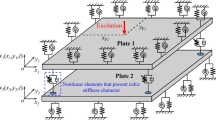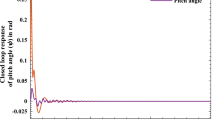Abstract
The paper presents an adaptive identification algorithm via data filtering and improved prescribed performance function for Sandwich systems with hysteresis nonlinearity. By developing a filter in which the filter is simple and easy to realize online and several variables, the estimation error vector can be derived. To improve the transient performance of estimator, a modified prescribed performance function is proposed to constrain the estimation error data through the usage of the predefined domain. For the constrained estimation error condition, the error transformation technique is utilized to simplify the design of the estimator thanks to that the restricted condition is transformed into unconstrained condition. To achieve the convergence of the parameter estimation and assure the predetermined property, a fresh adaptive law is developed. Moreover, the theoretical analysis indicates that the error can converge to a small region based on martingale difference theorem. According to the numerical verification and experimental results, the advantage and practicability of the invented estimator are inspected by comparing the estimators with unconstrained condition.
Similar content being viewed by others
References
D. Younesian, A. Hosseinkhani, H. Askari, and E. Esmailzadeh, “Elastic and viscoelastic foundations: a review on linear and nonlinear vibration modeling and applications,” Nonlinear Dynamics, vol. 97, no. 1, pp. 853–895, July 2019.
O. Doukhi and D. J. Lee, “Neural network-based robust adaptive certainty equivalent controller for quadrotor uav with unknown disturbances,” International Journal of Control, Automation and Systems, vol. 17, no. 9, pp. 2365–2374, September 2019.
Y. Gu, H. L. Wei, R. J. Boynton, S. N. Walker, and M. A. Balikhin, “System identification and data-driven forecasting of AE index and prediction uncertainty analysis using a new cloud-NARX model,” Journal of Geophysical Re-search: Space Physics, vol. 124, no. 1, pp. 248–263, January 2019.
X. Liu and X. Q. Yang, “Robust identification approach for nonlinear state-space models,” Neurocomputing, vol. 333, pp. 329–338, March 2019.
W. J. Chang, Y. H. Lin, J. Du, and C. M. Chang, “Fuzzy control with pole assignment and variance constraints for continuous-time perturbed Takagi-Sugeno fuzzy models: Application to ship steering systems,” International Journal of Control, Automation and Systems, vol. 17, no. 10, pp. 2677–2692, October 2019.
S. Ijaz, M. T. Hamayun, H. Anwaar, L. Yan, and M. K. Li, “LPV modeling and tracking control of dissimilar redundant actuation system for civil aircraft,” International Journal of Control, Automation and Systems, vol. 17, no. 3, pp. 705–715, March 2019.
F. Giri and E.-W. Bai, Block-oriented Nonlinear System Identification, Springer, 2010.
Z. Zhou, Y. Tan, Y. Xie, and R. Dong, “State estimation of a compound non-smooth sandwich system with backlash and dead zone,” Mechanical Systems and Signal Processing, vol. 83, pp. 439–449, January 2017.
J. Schoukens, L. Gomme, W. Van Moer, and Y. Rolain, “Identification of a block-structured nonlinear feedback system, applied to a microwave crystal detector,” IEEE Transactions on Instrumentation and Measurement, vol. 57, no. 8, pp. 1734–1740, August 2008.
G. Giordano, S. Gros, and J. Sjöberg, “An improved method for Wiener-Hammerstein system identification based on the fractional approach,” Automatica, vol. 94, pp. 349–360, August 2018.
E.-W. Bai, Z. Cai, S. Dudley-Javorosk, and R. K. Shields, “Identification of a modified Wiener-Hammerstein system and its application in electrically stimulated paralyzed skeletal muscle modeling,” Automatica, vol. 45, no. 3, pp. 736–743, March 2009.
Y. Rochdi, F. Giri, J. Gning, and F. Chaoui, “Identification of block-oriented systems in the presence of nonparametric input nonlinearities of switch and backlash types,” Automatica, vol. 46, no. 5, pp. 864–877, May 2010.
L. Fang, J. Wang, and Q. Zhang, “Identification of extended Hammerstein systems with hysteresis-type input nonlinearities described by Preisach model,” Nonlinear Dynamics, vol. 79, no. 2, pp. 1257–1273, January 2015.
A. H. Tan, “Wiener-Hammerstein modeling of nonlinear effects in bilinear systems,” IEEE Transactions on Automatic Control, vol. 51, no. 4, pp. 648–652, April 2006.
J. Sjöberg and J. Schoukens, “Initializing Wiener-Hammerstein models based on partitioning of the best linear approximation,” Automatica, vol. 48, no. 2, pp. 353–359, January 2011.
A. Naitali and F. Giri, “Wiener-Hammerstein system identification — an evolutionary approach,” International Journal of Systems Science, vol. 47, no. 1, pp. 45–61, April 2016.
M. A. H. Shaikh and K. Barbé, “Wiener-Hammerstein system identification: A fast approach through spearman correlation,” IEEE Transactions on Instrumentation and Measurement, vol. 68, no. 5, pp. 1628–1636, May 2019.
H. Ase and T. Katayama, “A subspace-based identification of Wiener-Hammerstein benchmark model,” Control Engineering Practice, vol. 44, pp. 126–137, November 2015.
B.-Q. Mu and H.-F. Chen, “Recursive identification of errors-in-variables Wiener-Hammerstein systems,” Automatica, vol. 49, no. 9, pp. 2744–2753, September 2013.
K. Tiels, M. Schoukens, and J. Schoukens, “Initial estimates for Wiener-Hammerstein models using phasecoupled multisines,” Automatica, vol. 60, pp. 201–209, October 2015.
J. Vörös, “Identification of cascade systems with backlash,” International Journal of Control, vol. 83, no. 6, pp. 1117–1124, May 2010.
R. Dong, Y. Tan, Y. Xie, and K. Janschek, “Recursive identification of micropositioning stage based on sandwich model with hysteresis,” IEEE Transactions on Control Systems Technology, vol. 25, no. 1, pp. 317–325, January 2017.
L. Li, X. Ren, and F. Guo, “Modified multi-innovation stochastic gradient algorithm for Wiener-Hammerstein systems with backlash,” Journal of the Franklin Institute, vol. 355, no. 9, pp. 4050–4075, June 2018.
Z. Zhou, Y. Tan, and X. Liu, “State estimation of dynamic systems with Sandwich structure and hysteresis,” Mechanical Systems and Signal Processing, vol. 126, pp. 82–97, July 2019.
M. Li and X. Liu, “Maximum likelihood least squares based iterative estimation for a class of bilinear systems using the data filtering technique,” International Journal of Control, Automation and Systems, vol. 18, no. 6, pp. 1581–1592, June 2020.
J. Ma, W. Xiong, J. Chen, and D. Feng, “Hierarchical identification for multivariate Hammerstein systems by using the modified Kalman filter,” IET Control Theory Applications, vol. 11, no. 6, pp. 857–869, March 2017.
J. Yang and H. Sakai, “A robust ICA-based adaptive filter algorithm for system identification,” IEEE Transactions on Circuits and Systems II: Express Briefs, vol. 55, no. 12, pp. 1259–1263, December 2008.
Z. Zhao, A. Tulsyan, B. Huang, and F. Liu, “Estimation and identification in batch processes with particle filters,” Journal of Process Control, vol. 81, pp. 1–14, September 2019.
X. R. Li and Y. Bar-Shalom, “Performance prediction of the interacting multiple model algorithm,” IEEE Transactions on Aerospace and Electronic Systems, vol. 29, no. 3, pp. 755–771, July 1993.
J. Na, A. S. Chen, G. Herrmann, R. Burke, and C. Brace, “Vehicle engine torque estimation via unknown input observer and adaptive parameter estimation,” IEEE Transactions on Signal Processing, vol. 67, no. 1, pp. 409–422, January 2018.
C. P. Bechlioulis, S. Heshmati-alamdari, G. C. Karras, and K. J. Kyriakopoulos, “Robust image-based visual servoing with prescribed performance under field of view constraints,” IEEE Transactions on Robotics, vol. 35, no. 4, pp. 1063–1070, August 2019.
T. Yu, L. Ma, and H. Zhang, “Prescribed performance for bipartite tracking control of nonlinear multiagent systems with hysteresis input uncertainties,” IEEE Transactions on Cybernetics, vol. 49, no. 4, pp. 1327–1338, April 2019.
B. Jayawardhana, R. Ouyang, and V. Andrieu, “Stability of systems with the duhem hysteresis operator: The dissipativity approach,” Automatica, vol. 48, no. 10, pp. 2657–2662, October 2012.
P. J. van Bree, C. M. M. van Lierop, and P. P. J. van den Bosch, “Control-oriented hysteresis models for magnetic electron lenses,” IEEE Transactions on Magnetics, vol. 45, no. 11, pp. 5235–5238, November 2009.
D. Jiles and D. Atherton, “Theory of ferromagnetic hysteresis,” Journal of Magnetism and Magnetic Materials, vol. 61, no. 1, pp. 48–60, September 1986.
C. C. de Wit, H. Olsson, K. J. Astrom, and P. Lischinsky, “A new model for control of systems with friction,” IEEE Transactions on Automatic Control, vol. 40, no. 3, pp. 419–425, April 1995.
F. Ikhouane and J. Rodellar, “A linear controller for hysteretic systems,” IEEE Transactions on Automatic Control, vol. 51, no. 2, pp. 340–344, February 2006.
J. Vörös, “Recursive identification of discrete-time nonlinear cascade systems with time-varying output hysteresis,” Nonlinear Dynamics, vol. 87, no. 2, pp. 1427–1434, January 2017.
C. P. Bechlioulis, G. C. Karras, S. Heshmati-Alamdari, and K. J. Kyriakopoulos, “Trajectory tracking with prescribed performance for underactuated underwater vehicles under model uncertainties and external disturbances,” IEEE Transactions on Control Systems Technology, vol. 25, no. 2, pp. 429–440, March 2017.
W. Si, X. Dong, and F. Yang, “Decentralized adaptive neural prescribed performance control for high-order stochastic switched nonlinear interconnected systems with unknown system dynamics,” ISA Transactions, vol. 84, pp. 55–68, January 2019.
C. P. Bechlioulis and G. A. Rovithakis, “Adaptive control with guaranteed transient and steady state tracking error bounds for strict feedback systems,” Automatica, vol. 45, no. 2, pp. 532–538, February 2009.
D. Wang, L. Li, Y. Ji, and Y. Yan, “Model recovery for Hammerstein systems using the auxiliary model based orthogonal matching pursuit method,” Applied Mathematical Modelling, vol. 54, pp. 537–550, February 2018.
L. Wan, F. Ding, X. Liu, and C. Chen, “A new iterative least squares parameter estimation approach for equation-error autoregressive systems,” International Journal of Control, Automation and Systems, vol. 18, pp 780–790, 2020.
G. C. Goodwin and K. S. Sin, Adaptive Filtering Prediction and Control, Prentice Hall, Englewood Cliffs, NJ, 1984.
H. Xu, F. Ding, A. Alsaedi, and T. Hayat, “Recursive identification algorithms for a class of linear closed-loop systems,” International Journal of Control, Automation and Systems, vol. 17, pp 3194–3204, 2019.
S. Wang, L. Tao, Q. Chen, and X. Ren, “USDE-based sliding mode control for servo mechanisms with unknown system dynamics,” IEEE/ASME Transactions on Mechatronics, vol. 25, no. 2, pp. 1056–1066, April 2020.
G. Zhang, J. Chen, and Z. Li, “Identifier-based adaptive robust control for servomechanisms with improved transient performance,” IEEE Transactions on Industrial Electronics, vol. 57, no. 7, pp. 2536–2547, July 2010.
Author information
Authors and Affiliations
Corresponding author
Additional information
Publisher’s Note Springer Nature remains neutral with regard to jurisdictional claims in published maps and institutional affiliations.
Recommended by Associate Editor Joseph Kwon under the direction of Editor Jay H. Lee. This paper is supported by the National Natural Science Foundation of China (No. 61433003, 61973036 and 61873246).
Linwei Li received his Ph.D. degree from Beijing Institute of Technology in 2019. He has been an instructor in the School of Electrical and Information Engineering at the Zhengzhou University of Light Industry. His research interests include nonlinear system identification, adaptive control.
Huanlong Zhang received his Ph.D. degree from the School of Aeronautics and Astronautics, Shanghai JiaoTong University in 2015. He is currently an Associate Professor at the Zhengzhou University of Light Industry. His research interests include signal processing, nonlinear systems, pattern recognition, machine learning, computer vision.
Xuemei Ren received her B.S. degree from Shandong University in 1989, and her M.S. and Ph.D. degrees in control engineering from the Beijing University of Aeronautics and Astronautics, in 1992 and 1995, respectively. She worked at the School of Automation, Beijing Institute of Technology as a professor from 2002. Her research interests include nonlinear system identification, neural network control, adaptive control, and servo systems.
Fengxian Wang received her M.S. and Ph.D degrees from Central South University, in 2016 and 2019, respectively. She is currently an intermediate lecturer in School of Electrical Information Engineering, Zhengzhou University of Light Industry. Her research interest includes fractional-order delayed systems.
Rights and permissions
About this article
Cite this article
Li, L., Zhang, H., Wang, F. et al. Adaptive Parameter Identification for Nonlinear Sandwich Systems with Hysteresis Nonlinearity Based Guaranteed Performance. Int. J. Control Autom. Syst. 19, 942–952 (2021). https://doi.org/10.1007/s12555-019-2020-2
Received:
Revised:
Accepted:
Published:
Issue Date:
DOI: https://doi.org/10.1007/s12555-019-2020-2




